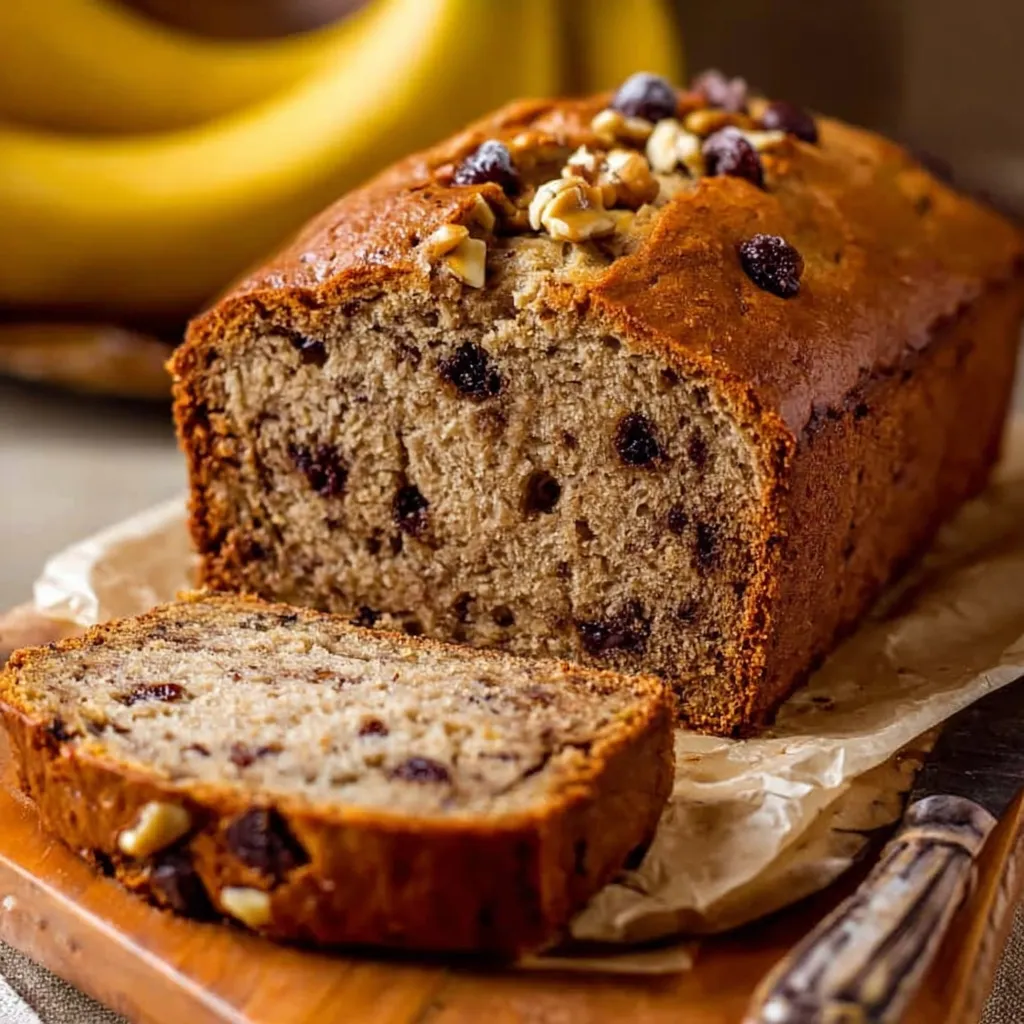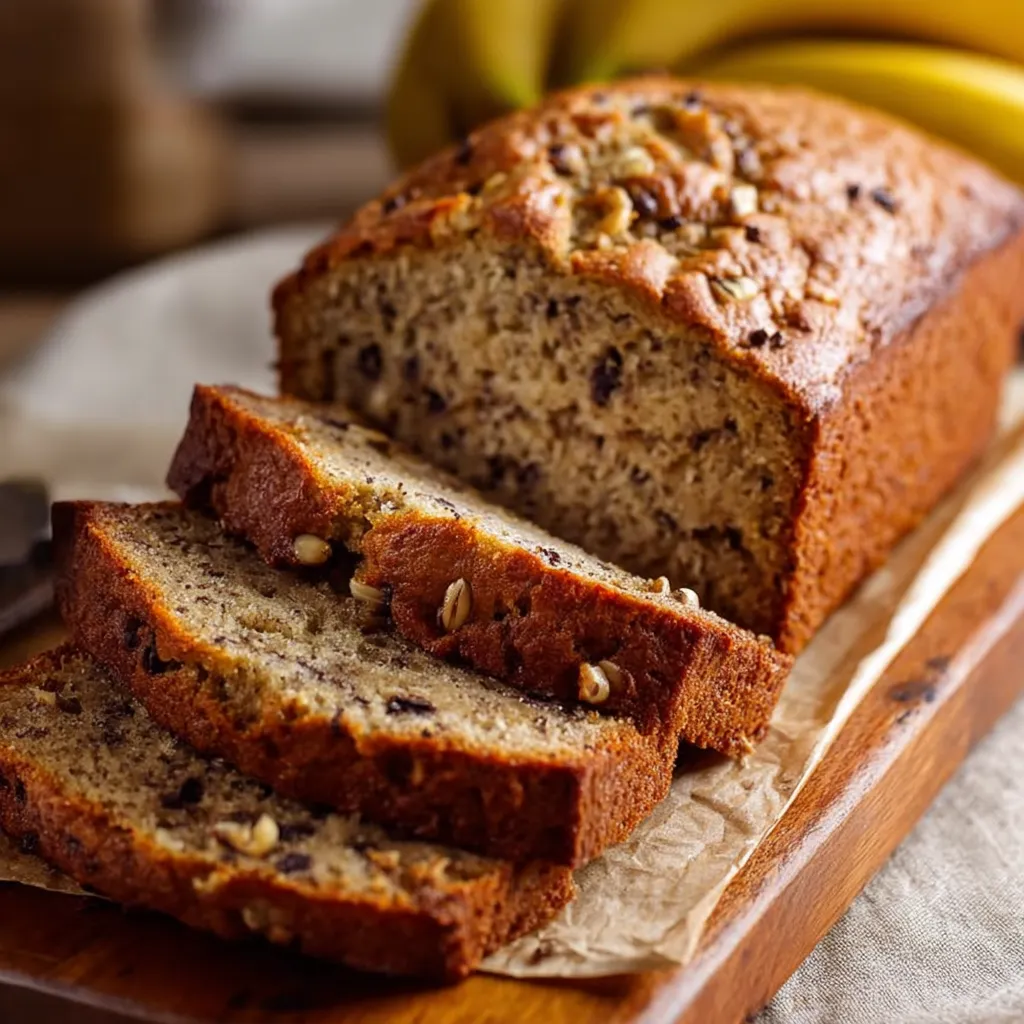 Save
Save
This foolproof banana bread recipe transforms those spotty, overripe bananas into a moist, tender loaf that fills your kitchen with the most comforting aroma. The recipe strikes the perfect balance between simplicity and flavor, creating a banana bread that's equally delicious for breakfast, snack time, or dessert.
I developed this recipe during a particularly rainy weekend when my family had a surplus of bananas turning brown on the counter. After several iterations, this version became our definitive favorite, with my children now strategically "forgetting" to eat bananas so they'll ripen for bread.
Ingredients
- 3 medium ripe bananas: the spottier and darker the better for maximum sweetness and flavor
- ⅓ cup melted butter: adds richness and moisture to the crumb
- ½ cup granulated sugar: just enough sweetness without overpowering the banana flavor
- 1 large egg: provides structure and richness
- 1 teaspoon vanilla extract: enhances the banana flavor with warm aromatic notes
- 1½ cups all purpose flour: creates the perfect texture balance
- 1 teaspoon baking soda: ensures proper rise and light texture
- ¼ teaspoon salt: enhances all the flavors
- Optional 1 cup semi sweet chocolate chips: adds pockets of melty goodness throughout
- Optional ½ cup chopped walnuts or pecans: introduces a delightful crunch and nutty flavor
Step-by-Step Instructions
- Preheat and Prepare:
- Heat your oven to 350°F and prepare your loaf pan with butter or cooking spray and parchment paper. The parchment creates handles that make removing the finished bread effortless. Allow all ingredients to come to room temperature, which ensures even mixing and proper rising.
- Mash Those Bananas:
- In a large bowl, mash the bananas until smooth but still with a few small chunks for texture. The riper your bananas, the easier they'll mash and the more natural sweetness they'll provide. I like using a potato masher for this step, but a fork works perfectly well too.
- Mix Wet Ingredients:
- Add melted butter to the mashed bananas and whisk until fully incorporated. The butter should be melted but not hot enough to cook the egg. Next, blend in the sugar, egg, and vanilla until the mixture looks smooth and slightly frothy. This step builds the moist foundation of your bread.
- Combine Dry Ingredients:
- In a separate bowl, whisk together the flour, baking soda, and salt. This even distribution prevents clumps and ensures the baking soda is evenly dispersed throughout the batter. The salt might seem minimal, but it's crucial for bringing out the banana flavor.
- Create the Batter:
- Gently fold the dry ingredients into the wet mixture, stirring just until no dry flour remains visible. Overmixing activates the gluten in the flour, which can make your banana bread tough rather than tender. If adding chocolate chips or nuts, fold them in now with just a few strokes.
- Bake to Perfection:
- Pour the batter into your prepared pan, smooth the top, and place in the preheated oven. Bake for 55 to 60 minutes, checking at the 50 minute mark by inserting a toothpick into the center. When it comes out clean or with just a few moist crumbs, your bread is ready. Allow to cool in the pan for 10 minutes before transferring to a wire rack.
The vanilla extract might seem like a small addition, but it makes a remarkable difference in the final flavor. My grandmother always added a splash more than called for, claiming it was her secret weapon for the most aromatic banana bread. Every time I make this recipe, I think of her kitchen and how she taught me to respect even the smallest ingredients.
Ripeness Matters
The success of your banana bread depends significantly on the ripeness of your bananas. The ideal bananas for this recipe should be heavily speckled with brown spots or even mostly brown. These overripe bananas contain more sugar, more moisture, and a stronger banana flavor that makes all the difference in your bread. If your bananas aren't ripe enough, you can speed up the process by placing them in a paper bag with an apple overnight, or bake them in their skins at 300°F for about 15 minutes until blackened.
Storage Solutions
Proper storage ensures your banana bread stays moist and delicious for days. Once completely cooled, wrap the loaf tightly in plastic wrap or store in an airtight container at room temperature for up to 4 days. For longer storage, slice the completely cooled bread, wrap individual slices in plastic wrap, and place in a freezer bag. These slices can be frozen for up to 3 months and thawed individually whenever a craving strikes. To refresh slightly stale banana bread, warm a slice in the microwave for 10 to 15 seconds or toast lightly in a toaster oven.
Creative Variations
While this classic recipe is perfect as is, consider these delicious variations to keep things interesting. For a tropical twist, add ½ cup toasted coconut flakes and replace vanilla extract with coconut extract. Cinnamon banana bread comes alive with 1 teaspoon of ground cinnamon and a sprinkle of turbinado sugar on top before baking. For a protein boost, substitute ¼ cup of flour with ¼ cup of protein powder. The most decadent version includes a swirl of Nutella created by adding dollops of the chocolate hazelnut spread on top of the batter and swirling with a knife before baking.

Recipe FAQs
- → How ripe should bananas be for the best banana bread?
The best banana bread comes from very ripe, heavily speckled bananas with dark spots. These overripe bananas are sweeter, softer, and impart more flavor to your bread. If your bananas aren't ripe enough, you can speed up the process by placing them in a paper bag with an apple or in a 300°F oven for about 15-20 minutes until blackened.
- → Can I freeze banana bread?
Yes, banana bread freezes exceptionally well. Cool it completely, then wrap tightly in plastic wrap and place in a freezer bag or airtight container. It will keep for up to 3 months. Thaw overnight in the refrigerator or at room temperature for a few hours before serving. You can also freeze individual slices for quick portions.
- → Why did my banana bread sink in the middle?
Sinking in the middle typically happens when the bread isn't fully baked, the oven temperature is too high, or you've added too much leavening agent. Ensure you're using the correct amount of baking soda and that your oven temperature is accurate. Also, avoid opening the oven door during the first 30 minutes of baking, and test for doneness with a toothpick before removing from the oven.
- → What can I add to banana bread for extra flavor?
Banana bread is incredibly versatile. Popular mix-ins include chocolate chips, chopped nuts (walnuts or pecans), dried fruit (cranberries or raisins), shredded coconut, or warm spices like cinnamon, nutmeg, or cardamom. For a tropical twist, try adding 1/2 cup of toasted coconut or diced pineapple. You can even swirl in peanut butter or Nutella before baking.
- → How do I know when my banana bread is done?
Test for doneness by inserting a toothpick into the center of the loaf at around 50 minutes of baking time. The toothpick should come out clean or with a few moist crumbs (but no wet batter). The bread should also pull away slightly from the sides of the pan, and the top should be golden brown. If the top browns too quickly but the center isn't done, cover loosely with foil for the remaining bake time.
- → Can I make this banana bread vegan or gluten-free?
Yes, this banana bread can be adapted for dietary restrictions. For a vegan version, replace the egg with a flax egg (1 tablespoon ground flaxseed mixed with 3 tablespoons water) and use plant-based butter or oil. For gluten-free, substitute the all-purpose flour with a 1:1 gluten-free baking flour blend. You may need to adjust the baking time slightly for these variations.
